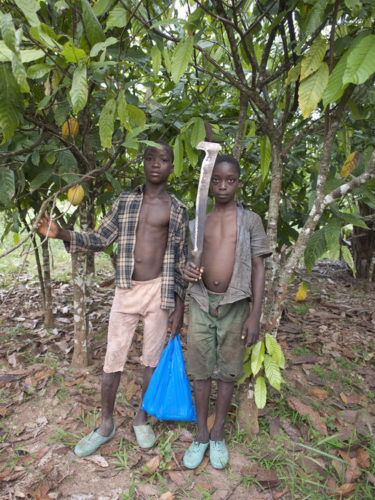Opinion: Child labor is on the rise; here’s how to prevent it
By Kunera Moore
Did you know that some of your favorite foods may be produced with child labor? The U.S. Labor Department, for example, named coffee as a product associated with child labor risk in 17 countries. This risk also remains widespread in cocoa, the main ingredient of chocolate: more than 60% of it is grown in Côte d’Ivoire and Ghana, where child labor remains widespread.
Due to the COVID-19 pandemic, more than 635 million students are affected by full or partial school closures, UNICEF announced last week. And shuttered schools combined with frozen economies means more children are driven into the workforce, according to a recent report by UNESCO, UNICEF, and the World Bank.
A staggering estimate of 160 million children worldwide are involved in child labor, according to a 2021 International Labour Organization report based on data collected before pandemic-induced school closures. This marks an 8.4 million increase since 2016.

Child cocoa workers in West Africa. Photo by Robin Romano.
Yet over the past 20 years, remarkable strides have been made to decrease the number of children involved in child labor worldwide. The Sustainable Development Goal of eradicating all forms of child labor by 2025 gained new momentum for this pressing challenge in 2021, the international year for the elimination of child labor.
We can’t afford to lose this momentum.
“Ensuring all children return to school and stay in school requires urgent investments in education, social security, and poverty reduction.”
Seventy percent of children in child labor are working in agriculture — work that can be dangerous and exhausting with long hours under the hot sun. The problem is particularly acute in the African continent. In Uganda, for instance, 22% of children ages 5 to 14 are involved in child labor and do not attend school. But the situation is also serious in a country such as Mexico, where 4% of children work and from that number, 30% work in agriculture.
Child labor must stop. But while banning child labor is commonly perceived as the silver bullet, it’s not enough.
Years of experience working in cocoa, coffee, tea, and other agricultural sectors has demonstrated that a punitive approach to child labor does not empower farmers and their communities to solve the real issue. Instead, farmers may attempt to hide child labor from auditors tasked with checking if they comply with labor standards.
Child labor is a complex issue with different social, economic, and political causes. These can include lack of access to education, weak enforcement of labor laws, lack of women’s empowerment, poverty, and insufficient social protection for the poor. On top of that, a prolonged pandemic has been added to the list.
So how should child labor be addressed? First, it is critical that all actions are tailored to specific contexts, which may range from small, remote family farms living below poverty lines to big plantations using migrant laborers who may bring their children to help with the harvest and earn a bit extra.
Imposing sanctions without addressing the root cause can be destructive for farming families and communities. It does nothing to lift farmers out of poverty or to solve child labor.
That is why the Rainforest Alliance, an organization that works to improve farmer livelihoods while protecting the environment, is one of several shifting to a new approach to tackle the global challenge of child labor.
The “assess and address” approach focuses on tackling the root causes of child labor and is aligned with the United Nations Guiding Principles on Business and Human Rights and the Organisation for Economic Co-operation and Development Guidelines for Multinational Enterprises.
This approach incentivizes farmers to tackle the root cause of child labor rather than try to hide it. Farms at risk are required to set up an internal committee that is responsible for preventing child labor, as well as forced labor, discrimination, and workplace violence and harassment. They work proactively on preventing child labor by researching and tackling the local causes, by raising awareness about what work children are allowed and not allowed to do, and by monitoring, identifying, and remediating cases.
Child labor isn’t tolerated on certified farms, but an identified case does not lead to immediate decertification. Instead, farms are required to remove the child from child labor and support the family to prevent further exploitation. This support can vary from helping a family to obtain their children’s birth certificates in order to register for school, to requesting better access to schools and improving the quality of schooling or supporting a farmer to improve the household income.
But organizations on their own cannot solve a challenge of this complexity and scale. Resolving it requires long-term collaboration between different actors.
First, governments need to ensure that child labor laws are in line with international labor conventions and that such laws are enforced through regular inspections. Governments also need to provide access to free and quality education for children as well as decent health care for everyone. Supporting vulnerable families through social protections and income support is also essential.
Second, companies can do more. Many major coffee companies have been at the front line of tackling child labor, through monitoring and remediation systems. Others have made good progress in mapping their suppliers down to the farm level, which is a critical first step. It’s also essential that companies collaborate with NGOs and governments on programs that tackle some of the root causes of child labor. Paying better prices to help farmers achieve a living income should also be part of the solution.
Third, certification organizations and other NGOs that work on creating more sustainable supply chains must continue to play their part by stimulating policy change and supporting families and communities to prevent and resolve child labor.
Crucially, consumers must do their bit too, demanding that brands pay farmers a better price for commodities such as coffee and cocoa, as well as support communities in farming more sustainably. Child labor in the coffee and cocoa sectors — but also in tea, hazelnuts, and other global supply chains — demands our urgent attention. All of us need to do our part to improve the livelihoods of farmers and farming communities around the world.
Ensuring all children return to school and stay in school requires urgent investments in education, social security, and poverty reduction. If that is not forthcoming, a whole generation of children could be lost to child labor.
[This article originally appeared at devex.com and appears here courtesy of the author.]
Kunera Moore
 Kunera Moore is the global theme lead for child labor at the Rainforest Alliance. She leads the organization’s child labor strategy and develops tools, training, and other support for farmers, civil society organizations, and business partners to better tackle child labor in agricultural supply chains. Moore brings more than 20 years of experience in human rights and sustainable development in international supply chains.
Kunera Moore is the global theme lead for child labor at the Rainforest Alliance. She leads the organization’s child labor strategy and develops tools, training, and other support for farmers, civil society organizations, and business partners to better tackle child labor in agricultural supply chains. Moore brings more than 20 years of experience in human rights and sustainable development in international supply chains.

